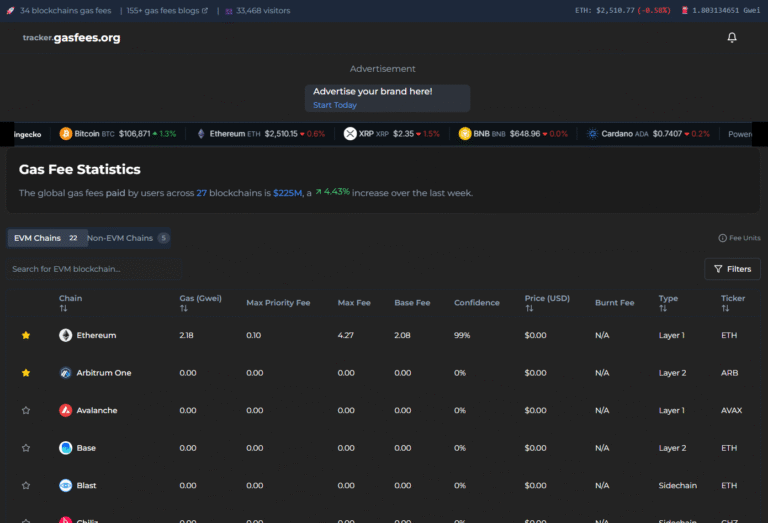
Latest Trends in Gas Fee Reduction Techniques
Written By: Mr. GasMan
Blockchain technology has revolutionized the way we transact, but high gas fees remain a significant challenge for widespread adoption.
Gas fees are transaction costs paid to miners or validators to process operations on a blockchain network. Over the years, innovative techniques have emerged to address this issue, driving down costs and enhancing the user experience.
Here, we explore the latest trends in gas fee reduction techniques shaping the blockchain ecosystem today.
1. Layer 2 Scaling Solutions
Layer 2 solutions operate on top of the main blockchain (Layer 1) to offload transaction processing, reducing congestion and fees.
- Rollups: Techniques like Optimistic Rollups and Zero-Knowledge (ZK) Rollups bundle multiple transactions into a single batch. This reduces the computational load on the main blockchain, cutting gas fees significantly.
- Sidechains: Platforms such as Polygon allow transactions to occur on a parallel blockchain, using the main chain only for final settlement.
- State Channels: These create a private channel between parties for off-chain transactions, with minimal gas fees for channel opening and closing.
Example: Optimism and Arbitrum are widely adopted rollup solutions for Ethereum, offering lower fees while maintaining security.
2. Directed Acyclic Graph (DAG) Architectures
Blockchains like IOTA and Fantom leverage DAG structures instead of traditional blockchains to eliminate the need for miners and reduce fees to near zero. DAG enables direct transactions between users without intermediaries, making it ideal for microtransactions and IoT use cases.
Key Benefit: Zero or minimal gas fees, particularly for high-frequency, low-value transactions.
3. Hybrid Consensus Mechanisms
New consensus algorithms blend proof-of-stake (PoS) with innovative optimizations to reduce the energy and computational resources required, indirectly lowering gas fees.
- Example: Algorand’s Pure PoS mechanism minimizes network costs by randomly selecting validators, ensuring efficiency.
- Eco-Friendly Alternatives: Chia Network and Casper are exploring greener and cheaper ways to achieve consensus.
4. Gasless Transactions
Several platforms are adopting gasless transaction models, where users don’t directly pay transaction fees. Instead, the cost is absorbed by developers, paid with alternative tokens, or offset by the platform itself.
Example: Projects like MetaMask Snaps enable gasless dApp interactions, broadening user access.
5. Fee Optimizations through Bandwidth and Energy (Tron)
Tron introduced an innovative model where users accumulate bandwidth and energy points by staking tokens. These points can be used to pay for transaction fees, often resulting in zero cost for frequent users.
6. Compression Techniques
Data compression methods are increasingly applied to reduce the size of transactions and smart contracts, thus lowering gas fees.
Example: StarkWare’s ZK-STARKs achieve significant data compression while maintaining high security, reducing costs for complex computations.
7. Multi-Chain Ecosystems
Blockchains like Polkadot and Cosmos facilitate interoperability between multiple chains, allowing users to perform transactions on less congested networks with lower fees. This multi-chain approach distributes traffic, effectively reducing fees on the primary network.
8. Improved Wallet Interfaces for Gas Optimization
Advanced crypto wallets now offer features to help users optimize gas fees by selecting the best network conditions or gas fee tiers.
Example: Wallets like MetaMask allow users to choose from low, medium, or high gas settings, depending on the urgency of the transaction.
9. Tokenized Gas Models
Blockchains like NEO and VeChain introduce tokenized gas systems, where holding the native token generates gas credits that users can spend on transactions.
10. Gas-Free Blockchains
Some blockchains eliminate gas fees entirely using innovative architectures:
- Nano: Feeless due to its block-lattice design.
- Bitgert: Boasts negligible gas fees, effectively creating an almost gas-free user experience.
Challenges and Considerations
While these trends are promising, certain challenges persist:
- Scalability vs. Security: Some fee-reducing techniques may compromise network decentralization or security.
- Adoption Barriers: New solutions need community support and developer integration to succeed.
- Sustainability: Gas-free models must ensure long-term viability without introducing hidden costs.
Conclusion
The blockchain industry is making strides in reducing gas fees through Layer 2 solutions, DAG architectures, hybrid consensus mechanisms, and innovative gas models. As these techniques mature, they will pave the way for more cost-effective and accessible blockchain applications.
By staying informed about these trends, users and developers alike can make smarter choices when selecting blockchain networks for their needs.
Ready to learn more?
Stay updated with the latest insights on gas fees at GasFees.org.
Share this blog:
Trezor Safe 5
Recent Gas Fees Post
Cryptotag Zeus
Why Use GasFees.org? 🛠️
📊 Real-Time Data: Get accurate gas fee updates anytime.
🌍 All Blockchains: Layer 1 and Layer 2 covered in one place.
💸 Save Money: Optimize transactions with our insights.
🔍 Easy to Use: Designed for beginners and experts alike.

Track Gas Fees in Real-Time – Save More on Every Transaction!
Monitor Ethereum and 33 other blockchains gas fees instantly with Gas Fee Tracker. Stay ahead of the market, optimize your transactions, and save on costs – all in real time










